Major Joshua Sprague's Ancestors |
Click on a name for info, click on an arrow to follow that branch, click Home to go to the main page, or click for an Alphabetic List of all Names. |
|
Note: Before 1752 the year began on March 25th. Dates between January 1st and March 24th were at the end of the year, not the beginning. |
| ~< Back to Chart >~ |
Captain William Sprague was born on February 2, 1691 in Smithfield, Providence, Rhode Island. He was the fourth of five children born to Jonathan Sprague, 42 and Mehitable Holbrook, 41 years old. When William was 23, he married Alice Brown, also 23 years old, on September 16, 1714 in Smithfield. For children, see Alice Brown below. In the History of Smithfield, Rhode Island it was written “For upwards of a century the Spragues were prominent actors in the religious and political history of old Smithfield.” Smithfield was a part of Providence before 1730, when the territory was set off and the town of Smithfield incorporated. To this date, the town of Providence extended north to the Massachusetts line. In October of 1720, William was made Freeman from Providence. A freeman was one who had taken the freeman’s oath, and which alone entitled him to vote in the nomination of magistrates and choice of deputies (representatives). This title was usually granted to men of standing in New England towns of colonial America. Before being admitted freeman, one had to subscribe to the freeman’s oath. Here is the form as administered in 1634: “I, (name), being by God’s providence, an inhabitant & freeman within the jurisdiccon of this commonweale, doe here sweare, by the greate & dreadfull name if the ever-lyveing God that I will be true & faithfull to the same & will accordingly yeilde assistance & support thereonto, with my person & Estate, as in equity I am bound, and will also truely indeavor to mainetaine & preserve all the libertyes & privileges thereof, submitting my self to the wholesome la wes & orders made & established by the same; and further that I will not plot nor practice any evilly against it, nor consent to any that shall shoe doe, but will timely discover and reveal the same to lawfully authority, no we here established, for the speedy preventing thereof. “Moreover I doe solemnly Boyne myself in the sight of God, that when I shall be called to give my voice touching any such matter of this state, wherein freemen are to deal, I will give my vote & suffrage, as I shall judge in my ne owner conscience may best conduce and tend to the publicize we ale of the body without respect of persons, or favor of any man. Some help me God, in the Lord Jesus Christ.” Freemen constituted a major component of the town government. Most government business was handled though town meetings, which the settlers thought were crucially important. They had crossed the Atlantic in order that they could enjoy freedom of choice. This was their form of representative government and they cherished it. William Sprague also took military duty seriously. From 1728 to 1731, he was a Lieutenant in the Providence County Militia; and in 1732 he bore the rank of Captain in the 2nd Regiment of the Providence County Militia. From there on, he was known as Captain William Sprague. William was an active member of the religious community. On August 31, 1738, William deeded “the land whereon the Baptist meeting house stands, to certain persons, for and in consideration of a meeting-house by my leave and consent erected and built for the worship of God, by my honored father, Jonathan Sprague, James Bal lou, James Walling and Richard Sprague, with the help of self and some others.” He apparently owned a significant amount of land in the Smithfield area as will be evidenced in some of the following transactions:
William’s wife, Alice must have died some time after this, because on August 26, 1744, William married Mrs. Mercy (Mary) Walling. William was 53 years old. Mercy was apparently previously the widow of a man named Cook, as her two sons bore that name as recorded in the following: “In the will of James Walling, Mercy is called wife of William Sprague, who was made executor, and to her was given one-third and to her children, Hannah Phillips, Joseph Cook, Abigail Cutter and Samuel Cook, also one-third.” Mercy died before 1751. William Sprague died during the war on October 20, 1778 in Smithfield, Providence, Rhode Island at the age of 87. |
| ~<^>~ |
Alice Ellis Brown was born on May 31, 1691, in Providence, Rhode Island to Daniel Browne and Alice Hearndon. On September 16, 1714, at the age of 23 she married William Sprague. They had at least six children, all born and most married in Smithfield — Nehemiah was born on January 5, 1717, and on April 26, 1738, married Mary Brown, whose relationship to our Browns is unknown; Ellis called Alice was born on October 2, 1720, and married Joseph Bassett in 1741; Sarah, born on February 10, 1722, married Stephen Sly on October 15, 1738; Samuel was born on September 12, 1724, and in 1745, married Jerusha Mitchell; Peter, born on September 19, 1726, was a seaman and his name has been recorded as Jetter; and ancestor Joshua. Some researchers say there was a son named Joseph, born in 1714, but no documentation supports him as their child. It is not known when Alice Ellis Brown Sprague died, but it was probably in Smithfield sometime before August 26, 1744, when her husband remarried. |
| ~< Back to Chart >~ |
Jonathan Sprague was born on May 28, 1648 in Hingham, Plymouth, Massachusetts. He was the eighth of ten or eleven children born to William Sprague, 39 and Millicent Eames, 34 years old and the second son named Jonathan, the first having died ten months earlier. When Jonathan was 22, he married Mehitable Holbrook, 20 years old, in Weymouth, Norfolk County, Massachusetts on July 20, 1670. See his wife below for children. In 1672, they were living near Jonathan’s brother John (who married Mehitables’s sister), and Mehitable’s father, William Holbrook, in Mendon, Worcester County Massachusetts where Jonathan was chosen Recorder of Mendon. In 1675 his father died and left him sixty acres of land in Providence County, Rhode Island, where he moved with his wife and children before 1680. On July 16, 1680, he was taxed 7 pence and on May 3, 1681 was made a Freeman of Providence. See William Sprague above for an explanation of Freeman. In 1687 His ratable (taxable) estate was 2 oxen, 6 cows, 2 mares, a horse, 18 sheep, 8 acres of planting ground and 6 acres of meadow. Jonathan Sprague was evidently a man of strong character. On December 13, 1687, he refused to take oath as grand juror and was fined 6 shilling, 8 pence. He was one of the most prominent and influential citizens of his town, and served frequently in public office. He was a member of the House of Deputies for sixteen of the years between 1695 and 1714, including Speaker of the House in 1703 and Clerk of the Assembly in 1707. He was a member of the Town Council of Providence from 1705 to 1712. From 1701 to 1703 he was Justice of the Peace.
Jonathan’s brother John had died in 1683 and his widow (sister of Mehitable) had later married James Bick. Jonathan had evidently done work on John’s land, and was seeking compensation from Bick, and brought the matter before the General Assembly. On October 27, 1703 the General Assembly ordered, in “re Jonathan Sprague v. James Bick, that the said James Bick shall, by the next sitting of the Assembly, bring under the hands of the said three brothers, Anthony, Samuel and William (Sprague), or any two of them, their result on the paragraph of their brother John's will, what shall be allowed their brother Jonathan for what he did on his brother John's land at Mendon.” On Jan 4, 1704 The General Assembly, having heard the report previously, in Jonathan Sprague v. James Bick, ordered, “execution should go forth against said Bick.” On May 20, 1711, Proprietors of Mendon (Massachusetts?) laid out to James Bick 25 acres which were a little above where Ballou's Bridge was later located, and about the same time land to Jonathan Sprague, whereon he lived, which was near the future location of the mill of the Harris Woolen Company at Mill River. Bick afterwards sold his land, and Sprague sold part of his to William Arnold.
Of a decidedly religious bent, Jonathan professed the Baptist faith, and preached as an exhorter, but was not ordained. On February 23 of 1722 or 1723, he wrote a long letter to three prominent Presbyterian Ministers in Massachusetts, John Danforth, Peter Thatcher, and Joseph Belcher, in answer to a letter they had addressed to him and other citizens concerning the establishment of a church in Providence. Mr. Sprague and his fellow Baptists failed to see the necessity of a Presbyterian establishment however and this correspondence gives his views in very vigorous and unmistakable terms. Jonathan Sprague died in March of 1741 in Smithfield, Providence County, Rhode Island at the age of 93 and is buried the Sprague-Dexter Cemetery in Lincoln, RI. |
| ~< Back to Chart >~ |
In Volume 15 of The Early Records of the Town of Providence, it states that on August 15, 1679, “Mehitteble Sprague . . Aged 30 yeares or there aboute . . Testifieth . .” that on the day before, she witnessed Hannah Pearce pulling out her one and a half year-old daughter, Elizabeth Pearce, from a well. Hannah testified that Mehitable helped in the attempt to revive Elizabeth without success. That same day, the court decided it was an accidental drowning. Mehitable Holbrook died on October 29, 1710 in Smithfield, Providence County Rhode Island at the age of 61. She is buried in the Sprague-Dexter Cemetery in Lincoln, RI and her gravestone is said to be the oldest stone in the cemetery (mouse over image right). The inscription reads “In memory of Mehitable
wife of Jonathan Sprague who died 1710 in her 62d year of her age.” |
| ~<^>~ |
Daniel Browne was born about 1638 in the city of Providence, Rhode Island, two years after Roger Williams was the first settler there. Many researchers believe he was one of five children born to Chaddus Browne (later Reverend Chaddus Browne) and Elizabeth Sharparowe, although no documentation can be found to support this. They, like many others, undoubtedly moved here for the religious tolerance of the colony. Williams' Providence soon became a refuge for persecuted religious dissenters, as he himself had been exiled from Massachusetts. Providence's growth would be slow during the next quarter-century—the subsuming of its territory into surrounding towns, difficulty of farming the land, and differing of local traditions and land conflicts all slowed development. Daniel was likely a Baptist. His father was a Baptist minister and two of his children married children of Jonathan Sprague, a fervent Baptist. When Daniel was about 31, he married the much younger Alice Hearndon on Christmas Day, December 25, 1669, in a Civil service in Providence. (See Alice’s bio below for details on the children.) The Chad Browne Memorial states that “He was a farmer, living ‘in the neck,’ on fifty acres of land, which, on Dec.10, 1706, he deeded conditionally to his two eldest sons, Judah and Jabez.” As early as 1672 he owned lands north of the Inman Purchase, near Loquassuck, near Benjamin Hearnden. He also owned lands in Gloucester, where several of his sons settled. He is mentioned several times in the Providence town records: on tax lists for several years between 1671 to 1681; he was chosen to serve upon the Jury of Tryars in Newport in 1677; he voted to send 3 people to the Newport Council meeting in 1679; and in 1686, he was chosen to serve as Grand jury man at the Generall Court of Trialls in Newport. In Volume 5 of The Early Records of Providence there is a deed, which shows that Daniel sold land on July 15, 1671. What makes this entry unusual is that not only did Daniell make his mark on the deed, Alse Browne also signed an A B on it, although she is not mentioned in the wording of the deed itself. Daniel Brown died on September 29, 1710, while he was away in Newport, at the age of 72. He died without a will, but an inventory of his estate was taken on October 27, 1710 by John Bullock and Richard Browne and presented to the Town Council on November 10th. The inventory was large and included the usual household items, carpenter tools, a cider mill and press, oxen, cows, sheep and 13 old barrills and sidar which he left at Newport. (Mouse over image left for details on this inventory, then click on it to enlarge it in a new window or tab.) On January 1, 1711, his wife and son Daniel were granted Administration of his estate. Unfortunately, his place of burial is unknown. |
| ~<^>~ |
Alice Hearndon was born about 1652 in Providence, Rhode Island. She was one of ten children born to Benjamin Hearndon and Elizabeth White. Some researches suggest she may have been a twin to her brother Joseph.
Daniel and Alice had at least nine children, all believed to be born in Providence — the eldest child Judah was probably born about 1670, he married a woman named Hannah and had six children, lived in Providence and Scituate, RI, and died in 1734; son Jabez married a woman named Ann and had two sons, lived in Providence, and he died in 1724; Sarah, born on October 10, 1677, married Thomas Angell in 1700, and had seven children; Jeremiah was a brick-maker and innkeeper who married Sarah Tucker and they lived in Smithfield; daughter Hallelujah was born about in 1680, married James Olney in 1702, had eight children and died in 1771 in her 90’s; son Hosanna born about 1684, married Mary Hawkins and then a woman named Ammitai, had several children with each wife, and he died in 1769; Jonathan, who sold land in 1713, that was confirmed by his two brothers; Daniel, born in about 1677, married Mary Sprague (the sister of ancestor William Sprague) in 1669, had six children, and co-administrated his father’s estate; and ancestor Alice, who married Mary Sprague's brother, ancestor William. Alice Hearndon Browne is said to have died on February 25, 1727, in Providence, Rhode Island. Her place of burial is unknown. |
| ~< Back to Chart >~ |
The three brothers, together with other compatriots were responsible for shaping the future of Massachusetts and for co-founding Charlestown where they settled. The names of Ralph, Richard and William Sprague stand at the head of the list of settlers in the record of the first meeting of the inhabitants of Charlestown. Edward Everett, in his oration commemorative of the arrival of Winthrop at Charleston, spoke of the Spragues saying, “They are the founders of the settlement in this place, and were persons of character, substance and enterprise; excellent citizens, generous public benefactors, and the heads of a very large and respectable family of descendants.” In 1629 William, in a boat, visited Hingham Massachusetts, about 18 miles away. William fell in love with Millicent Eames who lived there. They married on May 26, 1635 in Charlestown, Suffolk County Massachusetts. Edward was 26 and Millicent was 20 years old. Their first child, Anthony William was born on September 2, 1635, just over three month’s after they married. In the summer or autumn of 1636, together with his wife, son and father-in-law, William moved to Hingham where he was granted land. His lot was about two miles north of the Patent Line dividing old Massachusetts Bay Colony from Plymouth Colony. The lot, on Union Street "over the river" was said to be the most pleasant and best situated lot in Hingham. Other lots were granted to him for planting purposes from 1636 to 1647. These gifts indicate the esteem in which he was held by his fellow townsmen. He was one of the first planters in Hingham. After settling in Hingham they had ten additional children –see his wife, Millicent Eames, below for names. In 1645, William was chosen one of the seven Selectmen, “to order the prudential affairs of the town.” On March 28, 1651 he purchased from Thomas Hammond, Planter, a dwelling house with 5 acres of land adjoining his own homestead, together with other lands in that locality; also 20 acres on the opposite side of the river against the end of the aforesaid house lot. In 1662, he was the disbursing officer for the town as well as Constable of Hingham, Fenceviewer, and Collector of the town rates (taxes). William Sprague wrote his will on October 19, 1675 and it reads as follows: “In the Name of God, Amen. The nineteenth day of October, in the year of our Lord God, One thousand, six hundred, seventy & five. I, WILLIAM SPRAGUE, senior, of Hingham, in New England, being sick in body, but yet of perfect memory; praised by almighty God! do make and declare this my last will and testament, in manner and form following: Revoking, and by these presents, making void, and of no force, all and every will and wills heretofore by me made, and declared, either by word or writing, and this to be taken only, for my last will, and none other.
FIRST -- I will that all those just debts and duties that I owe in right and conscience to any person whatsoever, shall be well and truly contented and paid by my Executor hereafter named out of my Estate, with my funeral charges, which I will shall be first paid. Item -- I give and bequeath unto Millesaint Sprague, my loving wife, the sum of Ten pounds in money, and one Cow and one Horse.
Brother Ralph had become a Lieutenant and Richard a Captain. Their other accomplishments are too numerous to list here. They are both buried in Charleston, which they founded.Richard Sprague left no posterity. His sword, which is named in his brother William's will, was extant in 1828. When Ralph died at the age of 50 he left his widow Joanna with four sons and one daughter, Mary. Both Phineas and Mary were under the age of 21. Ralph Sprague with wife Joanna and brother William Sprague with his wife Millicent were the founders of the Sprague dynasty in New England. |
| ~< Back to Chart >~ |

Millicent Eames Sprague died on February 8, 1696, and was buried in Hingham, Plymouth, Massachusetts when she would have been close to 80 years old. (Mouse over image left for details on her death record, then click on it to enlarge in a new window or tab.) |
| ~<^>~ |
William Holbrook was born on June 14, 1620 in St Johns Church, Glastonbury, Somerset, England. He was the second of six children born to Thomas Holbrook, 21 and Jane Powyes, 20 years old. He was named after his paternal grandfather. The family sailed from Weymouth, England, March 20, 1635 (although his name was not on the passenger list) and immigrated to Massachusetts Colony in the ship Marygold and settled in what became Weymouth (Wharf pictured), undoubtedly named after their port of departure. In 1642, When William was 22, he married Elizabeth Pitts, 18, in Weymouth. They had seven children-see his wife below for names.
His wife Elizabeth died in 1696 and he married Abigail, daughter of Richard Wright, widow of Robert Sharp and of Thomas Clapp of Scituate. William Holbrook died on July 3, 1699, in Scituate, Plymouth, Massachusetts, at the age of 79. His will was dated September 9, 1696 and was probably a rewrite of a previous will. In it, he provided for his wife Abigail, giving her what she brought into the marriage and half of the increase from it, some household goods, and £3 a year, as long as she relinquished all rights to his estate. To his son Cornelius he gave all his lands in Weymouth; to his daughter, ancestor Mehitable Holbrook, £5 at marriage, but also left her £12, to be paid out of the £20 her husband ancestor Jonathan Sprague owed him (this must have been added later); to his son William, 20s and his Gun Called a Carbine; to his daughters Elizabeth Buck and Hopestill Reed, £20 each; £12 was left to his daughter Jane Balcom, with the stipulation she was to pay her daughter Alice 20s; and the residue of his estate went to his eldest son Samuel, who was named executor of the will. William included a stipulation that said if anyone contested the will, he or she would lose their share. The will was proved on July 17, 1699. |
| ~< Back to Chart >~ |
In The New England Historical & Genealogical Register, Volume 9, Elizabeth is quoted in reference to her mother’s inventory and estate as follows: “My Mother Mrs. Pitts oweth to me and to other in her sicknes and health as followeth, 6 Weekes attendance in her sicknes, at 6s. 8d. per weeke, ₤2 ; 20 weekes attendance in her sicknes, at 8s. per weeke, ₤8; . . .” She goes on to list the amounts that is owed to others in great detail. The assumption can be made that she spent much of her time taking care of her mother physically and financially after her father died. On August 1, 1655, the “Administration to the Estate of Mrs Elizabeth Pitts granted to Wm Holbrooke & Elizabeth, his wife.” Elizabeth Pitts Holbrook died in 1696 in Scituate, Plymouth, Massachusetts, at the age of 72. |
| ~<^>~ |
Rev. Chaddus Browne is believed to have been born about 1600 in High Wycombe, Buckinghamshire, England. Many researchers say he was the child of Arthur Browne and Dorothy Alchurch, buttheir son Chaddus was born way too early to be our Chad. Author Christopher Childs states “. . . the one ‘person of interest’ I’ve found in the right geographical area is John Browne, son of William, christened 10 Aug 1575 at Hambleden in Buckinghamshire . . . just half a dozen miles southwest of High Wycombe. However, in the absence of birth or baptismal records, parentage is very hard to prove.” This is a good possibility as our Chad did name his first son John. Chaddus married Elizabeth Sharparowe in High Wycombe on September 11, 1626. Their first child, John was born in England about 1630, see Chad's wife Elizabeth's bio below for more on the other children.
It is not known exactly when Chad Browne died. The only documentation of his death is from a George Kenrick deed dated December 16, 1663, where Chad is mentioned as deceased. But he could have died years before that date. Some researchers say Chad Browne died before September 2, 1650, at the age of 50, because a tax list with this date lists a Widdow Browne. Others say that in A History of the Baptists, Thomas Armitage quotes a 1738 sermon of Rev. John Callender that implies Chad Browne was living about the year 1653. Chaddus Browne was buried in the orchard of his home lot at what is now the corner of College and Benefit Streets. In 1672, his son John sold the house and lot to his brother James, with the reservation of “20 square feet, within the orchard where my father and mother are buried, with free egress.” That same day, James sold the property yo Daniel Abbott. When Browne University needed the land to build their University Hall, John and Moses Brown acquired the land for the university and Chad and Elizabeth’s coffins were moved to the North Burial Ground Cemetery, also known as the Rhode Island Historical Cemetery Providence #1. In November of 1792, a monument (mouse over photo right to view his footstone and see credits) was erected by the town of Providence which reads: “In Memory of Chad Brown, Elder of the Baptist Church in this town. He was one of the original Proprietors of the Providence Purchase, having been exiled from Massachusetts for conscience sake. He had five sons, John, James, Jeremiah, Chad & Daniel, who have left a numerous posterity. He died about A.D. 1665. This monument was erected by the town of Providence, Nov. 1792.” |
| ~< Back to Chart >~ |
Elizabeth Sharparowe is believed to have been born about 1604 in Melchbourne, Bedfordshire, England, to parents unknown. She married Chaddus Browne on September 11, 1626, in High Wycombe, Buckinghamshire, England when she was about 22 years old. She came to America with her husband and son John, on the ship Martin, which arrived in Boston, Massachusetts in July of 1638. Their known children were –John born about 1630 in England, married Mary Holmes, and became a prominent member of Providence, and died at 47 years old in 1677; Elizabeth Sharparowe Browne died in 1672 in Providence, Rhode Island at the age of 68. She was buried with her husband and her grave was relocated with his from the orchard on their home lot at what is now the corner of College and Benefit Streets, to the North Burial Ground. (Mouse over and click on image left to enlarge it in a new window/tab.) When a new memorial stone was placed on the new grave-sites, her name was not put on the stone.With or without a headstone to mark her grave, she was, in fact, relocated with her husband Chad. |
| ~< Back to Chart >~ |
Benjamin Hearndon was born about 1618, probably in England. His parents are unknown and many names have been suggested, but this researcher believes his father was also named Benjamin because there is an entry dated January 28, 1653/4 in Volume 15 of The Early Records of the Town of Providence that refers to him as Biniobin Herindin Junior. (He and others, requested that “ . . . the towns Common may not be damnified . . .”) Being that his son Benjamin was born in 1650, this could only refer to the elder Benjamin. Some say this is in error and should say Sr., but it doesn’t seem reasonable that in official town meeting records, one would call a man with a three year old child of the same name, Sr. It strongly suggests that their were two adult Benjamin's in the town. The family name has also been spelled Herendeen and Hearndale and several other ways, which makes research difficult. The surname generally became established as Harrington by the third generation in New England. Benjamin Hearndon was in Providence, Rhode Island in 1646, and in Lynn, Massachusetts in 1647, and back in Providence shortly afterwards. On July 9, 1647 he married Elizabeth White. Together they had a family of nine children. (See his wife’s bio for details.) Benjamin became an adherent of the Baptist faith and followed Roger Williams to Providence, Rhode Island. His daughter, ancestor Alice would later marry the son of the first Baptist minister in Providence. He was said to be a close friend of Roger Williams with whom one record says he was connected by marriage. Many of his descendants served in the Revolutionary War. Benjamin took the Oath of Allegiance on the 19th of the 11th month, 1648: “We whose names are hereafter subscribed, having obtained a free grant of 25 acres of land apiece with the right of commoning according to the said proportion of lands from it's free inhabitants, of the Town of Providence, do thankfully accept the same and hereby promise to yield active or passive to the authority of King and Parliament established in this colony according to our charter, adn to all such wholesome laws and orders that are or shall be made by the major consent of the Town of Providence, as also not to claim right to the purchase of said plantation nor any privileges of vote in Town affairs until we shall be received as freemen of said town of Providence.” There were 28 signatures including that of Banjamin Hearndean, mark, X. He signed many documents with his mark, and scarcely any two were alike in spelling. He even signed his X to the name of Herndell. In England the name is spelled Harrington, and variations of the name, Herendeen are not known among British Genealogists. His next official appearance in Providence is in 1651. Volume 15 of The Early Records of the Town of Providence states that on April 27, 1651 “It is Ordered that Benjamin Hernden shall have the privilege of 25, Acres, his home Lott next to the last field side fence.” The record goes on to say that in June 1652, he was taxed 4 shillings. This probably is the house and farm of 25 acres in Providence located near the corner of North Main Street and what was then called Harrington Lane, now Rochambeau Avenue. Part of his farm is now part of the North Burying Ground. He is in the earliest group of 25 acre men, received as inhabitants of Providence, Jan. 19, 1654. Also in this group is John Clawson, about whom more will be said later. Their families were said to be very intimate, probably related by marriage. Benjamin was involved in several scandals and criminal proceedings. The first was when he was probably living in Essex County, Massachusetts in December 1647 when he was presented in Lynn for beating his wife, as witnessed by Ezekial Gilbert and Henry Collins in the Essex Court files. On October 27, 1656, the authorities in Providence ordered that William White, the father of Elizabeth, be accommodated with a house lot adjoining the house lot of Benjamin Herendeen and further ordered that Benjamin Herendeen enlarge his lot. On February 17, 1659, Benjamin Herendeen was brought into the Providence, RI court by a 10-pound bond if he didn't appear to answer to “a breach of the peace and fight committed on the family of William White, of this Towne . . .” William White was also bonded to 10 pounds to appear in the next town court in Providence to prosecute Benjamin. On August 31, 1659, an entry in the town records states that Sammuell Bennit brought an action of trepasse against Benjamin citing he “suffered greate damage . . .by ye Swine of ye defendant & he refusing all faire meanes of Satisfaction.” Benjamin was fined five pounds. In 1661, John Clawson, a hired servant of Roger Williams, was fatally attacked with a broad ax by the Indian, Waumanio, from behind Barberry Bushes near the Burying Ground. Before he died Clawson named Benjamin Herendeen as the instigator and pronounced a curse on him and his descendants that "he and his posterity might be marked by split chins and be haunted by Barberry Bushes." In Rhode Island Trials, Volume 1, page 70, it states, “the Indian confessed to the killing and was sentenced to be executed. Benjamin Herendeen was charged as an accessory, but he plead not guilty and the jury found him not guilty and cleared him.” The History of the State of Rhode Island and Providence Plantation by Samuel Greene Arnold states that “More than a century later, testimony was collected in proof of the fulfillment of this dying malediction. By this it appears that the descendants of the murderer were remarkable for the excavated or furrowed chin, which caused the curse of Clawson to be kept in remembrance, and many a quarrel was excited among them at huskings and frolics by mention of the word ‘Barberry bushes.’ The book continues in a footnote with “The curse of Clawson, with the singular and undoubted evidence of its fulfilment, collected from the most respectable sources by the Hon. Theodore Foster, and also the account of the murder and trial, with a copy of a letter from Roger Williams to the town of Providence, dated May 11th, 1661, concerning the estate of the murdered man are preserved in the Foster MS. Papers. In Volume 5 of The Early Records of the Town of Providence, a memo is printed which is believed to be attached to the Williams letter, which says in part: “This Paper was taken to Newport by Theodore Foster and was read in Captain Garner's Packet on Sunday, June 27th 1814 the Gentlemen then Present returning from the General Assembly to Providence, among whom was present, Robert Harris, Esq who informed them . . .” of the attack on Clawson as described above. It goes on to indicate that the incident was“instigated thereto by John Benjamin Harrington.” In Volume 4 of The Early Records of the Town of Providence an entry dated October 16, 1662 states, “William White of Boston . . . Bricklayer . . . with the free Consent of Elizabeth his wife for . . . the sum of Twenty pound sterling . . . payd by Elizabeth wife of Benjamin Herenden of Providence . . . Confirmed unto . . . Benjamin Harenden a parcel of land together with the dwelling house and other housing . . .” This was about 25 acres of land. Just two months later on December 25, 1662, in Volume 1 of the same records, we find that he sells some of this land to Zacariah Roades “for a valuable sum of money.” Does this indicate that Elizabeth’s father gave up, moved to Boston and left his daughter with her abusive husband?
“Providence, 11th day of March, 1674-5, so-called. Received this present day above said, of Ben Hernden six shillings nine pence which makes up ye full sum of eleven pounds for which I sold to him ye home and land which was John Clawson's, and hereby receiving this last payment of Benjamin Hernd I declare my self full satisfied and doe hereby fully discharge the said Benjamin of ye payment aforesaid. Witness my hand, Roger Williams.” (John Clawson was the victim of the murder talked about above). On May 4, 1670, the General Assembly imposed a fine on him, but the Assembly remitted this fine. On July 1, 1679 he was taxed 1s. 3d. On March 16, 1680, upon his petition to the General Assembly to remit sentence on General Court of Trials against his wife, Elizabeth, he pleaded great poverty and debility of himself and his wife, and the fine was absolutely remitted. On May 26, 1684, he had 60 acres of land laid out to him, and April 20, 1685, he and his wife deeded son Benjamin 60 acres with meadow, he being destitute of a place of settlement. March 3, 1686, he and wife deeded son Joseph 67 acres for his well being and settlement, part of land situated 10 miles from Providence. In Austin’s Genealogical Dictionary of Rhode Island, it states that Benjamin Hearndon’s will was dated February 1, 1687, and was presented to the court on April 4, 1688, but the inventory, totaling 42 pounds, 7 shillings, and 2 pence, was taken on May 27, 1687. Then on September 1, 1687, his estate was taxed four shillings and 2 pence. Other researchers have stated his will was dated 1686, but do not give a source. These dates don’t make sense, as the will is usually presented as soon as someone dies and then an inventory is ordered by the court. Austin also does not give a source nor does he state that he adjusted the year for the two month difference, but this researcher believes he did, and the dates are correct, with one clarification. The April 4, 1688, date was not the date that the will presented for the first time to the court, but was the date the will was probated or finalized. This means that Benjamin died sometime between February 1st and May 27, 1687. Researchers say he died in Providence Rhode Island and is buried in the North Burial Ground there, but again, no source is given. |
| ~< Back to Chart >~ |
Elizabeth White is said to have been born between 1628 and 1630, probably in England, one of seven children born to Elizabeth and William White. She most likely came with her parents to New England in 1645. Researchers say she married Benjamin Hearndon on July 9, 1647, in Providence, Rhode Island. Together they had a large family, all thought to have been born in Providence — Benjamin Jr. was born in 1650, married Lydia Wells in 1687, and died on April 18, 1694; Joseph, said to have been a twin with ancestor Alice, was born about 1652, married Sarah Tillinghast, and died the day after his brother Benjamin died; ancestor Alice; Sarah born between 1654-1656, married David Whipple on May 15, 1675, and died in her early 20’s on April 2, 1677; Mary, who was born about 1658, married Captain Andrew Edmonds in mid October, 1675; William born on August 27, 1660, married twice, first Esther and then Deliverance; John born on October 9, 1662, married Lydia Cranston on March 28, 1687; Thomas, born about 1665, married a woman named Hannah; and Isaac born about 1668, married a woman named Sarah and lived and died in Norwich, New London County, Connecticut. Unfortunately birth records for these dates cannot be found. Elizabeth and Benjamin’s marriage was turbulent. He was known to beat her and was involved in several criminal charges, including an assault on her father. There is also an Essex County, Massachusetts Quarterly Court record dated March 1, 1647/48 of Elizabeth being presented for stealing clothes from Mary Pray and ordered to make double restitution. In 1688, after Benjamin died in 1687, Elizabeth married Richard Pray, whose first wife Mary died in 1686. This Mary Pray was the same woman that Elizabeth stole clothes from. It is also interesting to note that on the same day that Elizabeth faced her stealing charges, Richard was charged with swearing, cursing and beating his wife Mary. Witnesses gave details of their fights which include: “he often heard Prey call his wife jade and roundhead, and curse her, wishing a plague and a pox on her; . . . Prey took up a long stick about the size of the great end of a bedstaff and . . .struck at his wife; . . . gave his wife a kick and kicked her against the wall; . . . Prey took his porridge dish and threw it at her. . .. When a member of the court reprimanded him for his actions he said, “he would cripple her and make her sit on a stool, and there he would keep her.” Prey was “fined 10s. for swearing, 10s. for cursing, 20 s. for beating his wife, and 40 s. for contempt of court, or to be whipped at the Iron works.” On October 20, 1688, records show that “Richard Pray . . . & Elizabeth his wife, late wife of Benjamin Hearnton . .” quitclaimed her land to her son Isaack, who then sold it back to her on February 10, 1689. Elizabeth’s husband Richard died on December 25, 1693, after which, her son Isaac tried to sell the land he had previously sold back to her. In Volume 5 of the Early Records of Providence on June 9, 1701, widow Elizabeth Prey states that Isaac doesn’t have a right to sell as follows: “These are therefore to signifie unto all persons what so ever, That to the said Isaac Hearneden hath no Right, Title nor Interest to ye Said house, . . . But that all the Right, Title, & Interest to the said house & lands wholy belongeth unto me, Elizabeth Pray (widow), formerly Elizabeth Hearnden . . .” She goes on to “forbid all & Every person or persons whome so ever; for Bargaineing or purchaseing the said house & lands, or any part hereof, of the said Isaac Hearnden:” In Volume 4 of this same series of records, we find that on December 13, 1701, right before she died, she sold to Joseph Whipple, a house with 10 acres, part of it being the land that was owned by her father, bought by her first husband Benjamin, and willed to her for life, which she gave to her son Isaac, who then sold it back to her. Researchers say that Elizabeth White Hearndon Pray died on December 31, 1701in Providence, Rhode Island, and was buried in the North Burial Ground there. |
| ~< Back to Chart >~ |
E
As the 16th Century gave way to the 17th, so the County of Dorset's farming community enjoyed years of prosperity, the main elements being dairy products and the raising of sheep for their wool. It was recorded then that the County produced the largest number of shorn wool packs in England. Most of it was spun and woven in the rural areas, giving employment to the outlying farms. The products were also exported through Weymouth to the Continent particularly Brittany and Normandy.
“The Vith [6th] daye [day] of June in the yeare [year] of our Lord God, one thousand six hundred and fourteen [1614]. In the name of God, Amen I, Edward Sprague of Upwey in the County of Dorset, ffuller, [Fuller] being sicke [sick] and weake [weak] of body, but well and perfect in mind, thanks being unto Almighty God, do ordaine [ordain] and appoint this my last Will and Testament to be made in manner and forme [form] following. That is to say, ffirst [first] of all, I do bequeath my Soul unto Almighty God, my Saviour and Redeemer, and my bodie [body] to be buried within the church yard. As for such temporall [temporal] goods as God has blessed me withall [withal], I give and bequeath as hereafter follows: viz. I give unto the parrishe [parish] church of Upwey tenne [ten] shillings. Item:- I give unto the poor of the said parrishe [parish] of Upwey tenne [ten] shillings Item:- I give unto unto Ralphe Sprague my eldest sonne [son] one of the oldest paire [pair] of shears in my shoppe [shop] and one lesser payer [pair] called the quarrel. Item:- I give and bequeath unto my eldest daughter Alice Sprague fiftie [fifty] poundes [pounds] to be paid within one yeare [year] after my decease. Item:- I give and bequeath unto Edward Sprague my second sonne [son] two paire [pair] of shears and twentie [twenty] poundes [pounds] to be paid likewise within one year after my decease. Item:- I give and bequeath unto Richard Sprague my third son twenty poundes [pounds] to be paid when he shall be one and twenty years of age. Item:- I give and bequeath unto Xpofer [Christopher] Sprague my fourth sonne [son] twenty poundes [pounds] to be paid when he shall be of the age be one and twenty years. Item:- I give and bequeath unto William Sprague my youngest sonne [son] xx L [twenty pounds] to be when he shall be of the age of one and twenty years. All the rest of my goods movable and unmovable I give and bequeath unto Christian Sprague my wife whom I do make my whole (sole) executrix of this my last Will and Testament. Memorandum: that if Richard Sprague , Christopher Sprague or William Sprague shall happen to die either of them before they shall be of age of one and twenty years, that then their legacie [legacy] to be devided [divided] betweene [between] the other two or if two of them shall happen to dye [die] before they shall be of the age of one and twenty years that the their legacies to remain to the other then living ffinally [Finally], I do appoint Henry Samways and William Bryar overseers of this my last Will and Testament in the presence of those whose names are underwritten John Bishoppe [Bishop] John Taylor his marke [mark] Memorandum: that whereas the living of the aforesaid Edward Sprague doth fall unto his sonne [son] Ralph Sprague after his decease the said Ralph Sprague doth upon his fathers request promise that his mother Christian Sprague shall quietly enjoy the said living until he shall be one and twenty years of age.” On October 13, 1614 probate was granted at the Prerogative Court at Canterbury in London to Christian Sprague widow and executrix.
Edward Sprague was buried on October 13, 1614, as he requested in his will, in the St Laurence Churchyard cemetery in Upwey, pictured left. |
| ~<^>~ |
Christian’s surname and ancestry is unknown. She is said to be the Christian Holland who was born on March 30, 1578 in Stokenham, Devon, England to John Holland. This birth record only lists a father named John, but no mother’s name is listed. Many researchers believe her mother was Agnes Rolleston, but give no documentation. Although her husband called her Christian in his will and this birth record says the same, many genealogists say her name was Christiana. Christian married Edward Sprague about 1595. They had six children, all born in Dorset, England – Alice born about 1597, married Richard, the brother of ancestor Anthony Eames on June 5, 1615, in Fordington; Ralph on June 20 1599, whose son Richard married Katharine, the sister of ancestor Stephen Richardson; Edward born on December 15, 1601, is said to have been married, died in Upwey at 32 years old; Richard about 1605, was a merchant in Suffolk County, Massachusetts, married a woman named Mary, but never had children, and died on November 25, 1668, in Charlestown; Christopher about 1607, who died in March of 1625, in Fordington, at the age of 18; and ancestor William. Christian’s husband Edward Sprague died in October 1614. At that time her oldest child Alice was 17 years old, soon to be married and her youngest son William was five. So she married John Corbin, of Upwey. John was an overseer of the parish church in Upwey in 1641 and 1642. It is very likely he raised Christian’s children as his own, as a letter he wrote to Ralph in America, dated March 25,1651, shows his affection for him. He calls Ralph his “Loving sonne” and signs it “Yor loving ffather in law till death.” It is believed the term ffather in law refers to the fact that he considered himself his father by the marriage to Ralph’s mother. In the letter he goes on to say “that my brother-in-law John Holland should report that hee receaved a letter from your brother Richard that you were dead, but I give God praise that I heare to the contrary.” Unfortunately at the time this letter was written Ralph Sprague had been deceased four months, so the report which Richard Sparague made to John Holland was true. Some researchers say that this letter is proof of Christian’s surname, but John Holland could have been married to Christian’s sister, Corbin’s sister, or some other way, legally related to Corbin. So her ancestry is really uncertain! It is said that Christian Sprague Corbin died on March 25, 1651, the same date as the letter, but this is unproven. Corbin makes no mention of his wife in the letter, but refers to “all our loving friends . . . bee very glad to see you heere with us before wee dy. . . ” It is not known if he was referring to his wife and himself, or his friends. It may be that she had already died by this date. Whenever she died, it is believed it was in Upwey. |
| ~<^>~ |
| William Pitts may be the name of Elizabeth Pitts Holbrooks’ father. Many researchers believe he was the William who came to the New World on the Diligent, which sailed from Ipswich, Suffolk in June 1638 and arrived August 10, 1638 at Boston. This William was described as a servant of Philip James of Hingham, Norfolk by Daniel Cushing, also a passenger on the Diligent, and does not list a child nor wife for William. Savage tells us that this William married a Susanna Alley on December 7, 1655. Being that Elizabeth Pitts Holbrook’s mother died in August of 1555, this could very well be him, but it is odd that he is not mentioned in her probate records. There were many other men with the name William Pitts or Pitt living in Massachusetts at the time. One was granted permission to build ships at Konohasset in 1675. Even Clarence Almon Torrey, in his book New England Marriages Prior to 1700 puts a question mark after William’s name and list their marriage as “Pitts, ? /William? & Elizabeth ? (-1655); b 1639, b 1634?; Dorchester.” Unfortunately, there is no proof of a connection between a man named William Pitts and ancestors Elizabeth and her mother Elizabeth Pitts. |
| ~< Back to Chart >~ |
| Elizabeth, the mother of Elizabeth Pitts Holbrook, has an unknown ancestry as her maiden name is unknown. Not much is known about her, but James Savage in volume 3 of his book A Genealogical Dictionary of the First Settlers of New England, places an Elizabeth Pitts in Gloucester in 1639. Gloucester is 50 miles away from Weymouth, so this may not be her or Savage may have made one of his errors. The Records of the First Church in Charlestown show that they admitted an Elizabeth Pitts into their congregation on April 13, 1643. Charlestown is only 18 miles from Weymouth. Volume 1 of The Records and Files of the Quarterly Courts of Essex County, Massachusetts includes on two dates, June 25th and September 24th of 1639, a case in which an Elizabeth Pitts is suing a Daniell Salmon, for money due her. “Elizabeth Pitts* was of Dorchester. She signed a receipt for 6li : 10s. on 21 : 9 mo : 1639.” (That is November 21, 1639.) The * indicated that it was an autograph, not a mark. It seems that this Elizabeth was educated and knew how to write her name. Later in the case she is called Mrs. Pitts. One would expect that if her husband was alive and with her, he would be the one involved in the case, not her. So if this is our Elizabeth, then the William Pitts who came in the Diligent, is not her husband. A few researchers say that Elizabeth who married William Holbrook was called the daughter of the widow Elizabeth Pitts when she was married in 1643. Unfortunately, there is no documentation to support this. We don’t even know for sure if Pitts was her surname when she had Elizabeth-she could have had a second husband! We do know for certain that a woman named Elizabeth Pitts is the mother of ancestor Elizabeth because of the inventory taken upon her death, which reads as follows in volume 9 of The New England Historical & Genealogical Register: “Inventory of the goods of Mrs Elizabeth Pitts deceased at Waymouth, prised by John Whitmarsh, Thomas Bayly, Samuell Packer, James Nash. Amt. ₤16. 06. 06. "My Mother Mrs. Pitts oweth to me and to other in her sicknes and health as followeth, 6 Weekes attendance in her sicknes, at 6s. 8d. per weeke, ₤2 ; 20 weekes attendance in her sicknes, at 8s. per weeke, ₤8; Mr Allcocke, for Phisicke and Cordialls, 7s; Mr Allcockes Journeyes hither, 7s; for things fetched at Thomas Dyars, 12s. 02d; debt to John Phillips, of Boston, 3s. 6d., & c. Whole amount ₤13. 16s. 8d. Administration to the Estate of Mrs Elizabeth Pitts granted to Wm Holbrooke & Elizabeth, his wife, 1 Aug 1655.” Elizabeth died before August of 1655 in Weymouth, Norfolk County, Massachusetts. |
| ~<^>~ |
William White was born about 1603, probably in England. His ancestry or place of birth are unknown, but his place in the history of Alchemy is well documented in a handful of books and articles. The most informative is the article, “A Most Exquisite Fellow” — William White and an Atlantic World Perspective on the Seventeenth-Century Chymical Furnace, written by Bruce D. White and Walter W. Woodward. This article indicates that William was a well respected inventor, scientist, a wizard of industrial efficiency and an expert furnace-maker. He attained his skills studying under the masters in the Alchemy field. He lived and worked for many years with Dr. John Everad, improving his skills in the field of furnace making. Through Everad, William met many men with an interest in developing New England. After Everad died in 1643, William began to look toward New England. William’s 15 inventions are documented in the Hartlib Papers under the name of Catalogue of Inventions, Mr. White. The Exquisite Fellow article lists and discusses them and tells us that the original name of this list was written in William’s hand as A Cattallogg of secrets good for a Common-welth or plantation, and dates to about 1642/3.
In Volume 3 of State of Rhode Island and Providence Plantations at the End of the Century: A History, it states that “In 1656 William White of Boston, a bricklayer, was in providence and by order of the town was to be accommodated with a house lot.” In Sidney Smith Rider’s 1898 periodical Book Notes, William is called The First Bricklayer in Providence. This article tells us that early in 1656, he was granted a house lot adjoining his son-in-law "...Benjamine Herndell"; in 1657 and in 1658, he was allowed the use of even more land (25 acres) for his "meddow" near another son-in-law, Thomas Walling (aka Wallen). Rider goes on to say that William had the same rights to the land as everyone else at the time, “the right to use, but not the right to transmit. The use of so much land enabled him to become a freeman. In Volume 15 of the Providence Town Records, it states that on February 17, 1659, both William and his son-in-law Benjamin were indepted to the state of England 10 pounds. This was because Benjamin attacked William and William was charging Benjamin ". . .for breach of peace and fright, Comitted on your family." By 1662, he was ready to return to Boston and William sold some of his land to his son-in-law Benjamin. In Volume 4 of the Providence Town Records on October 16, 1662, it states that, “William White of Boston in New England, bricklayer, . . . with the free consent of Elizabeth, his wife for . . . the sum of Twenty pound sterling . . . payd by Elizabeth, the wife of Benjamin Herenden of Providence in New England sold to Benjamin Harenden a parcel of land together with the dwelling house and other housing . . . twenty & five acres, be it more or less.” In Volume 1 of this same series, in a deed for Benjamin Hearndon dated December 25, 1662, it states that “. . . William White formerly inhabetant of the aforesaid town of providence, but now of Boston in New-England . . .“
William White's will was written on October 13, 1673, and it was proved January 31, 1673/4. Most researchers set his death date as October 30, 1673, in Boston, but his probate inventory papers state he died in the 10th month which was December at that time. In his will, he left to his wife and children “...all my vissable estate so long as she was a widowe and to have her thirds if she remarried; two Sonnes Isaacke & Cornelius White; two sonnes & 1 daughter Susanna Waggett, wife of Thomas Waggett after the decease of wife; to son William White 5 shillings... to other 3 daughters, Elyzabeth Harnden, wife of Benjamyne... Margaret Wallen, wife of Thomas Wallen, and Usrulla Bennett, the wife of John Bennett each 4 shillings.” (Mouse over and click on the will image right to enlarge it in a new window/tab.) |
| ~< Back to Chart >~ |
Elizabeth’s maiden name and birthdate are both unknown, but some researchers say she was the Elizabeth Jackson who married William White on January 19, 1629, at the Saint Gregory By Saint Paul church in London, England. A text record for this marriage has been found, but there is no indication that this is our William and Elizabeth. It is believed she came to America with her husband and children in 1645. They lived mainly in Boston, Massachusetts and Providence, Rhode Island and had at least seven children, three sons and four daughters, the first six most likely born in England. Unfortunately not all birth dates or places of birth are known – ancestor Elizabeth; Margaret, may have been baptized on March 17, 1630, at Saint Martin In The Fields church in Westminster, London, England; William, born about 1633, married Phillip Wood in Boston on August 4, 1653; Usrulla, may have been baptized on July 14, 1639, at Saint Katherine by the Tower in London, and married John Bennett in Providence, RI; Susanna, born about 1640, and married Thomas Wagget; Isaac, born about 1643 and is said to have married a woman named Susanna; Cornelius, who was born on January 7, 1646/47 in Boston, married Priscilla Davis. Their daughter Margaret had a very interesting life. She married a man named Robert Colwell in about 1655. While still married in about 1666, she ran away with her married neighbor Thomas Walling (aka Wallen). Although both deserted their families, only Margaret was punished. Margaret had returned to Boston and was ordered to be publicly whipped 15 stripes and was fined £5 in October 1666. Her husband Robert Colwell divorced her on July 2, 1667 and he went to Long Island. Her lover Thomas obtained a divorce and married Margaret on June 19, 1669, but he died in 1674. She then married Daniel Abbott Jr. on December 25, 1678 in Providence. He took her to court as stated in William B. Saxbe Jr.’s article Thomas Walling & His Way With Women printed in The American Genealogist in April 1998:“'Daniel Abbott, her third husband...filed the following prohibition against her: 'Whereas my wife Margrett through her Maddnes of folly & Turbulency of her Currupt will, hath often Threatened to Ruinate my family, Routeing me (as she saith) of horse & Foote, Destroying me Root & Branch, putting out one of her owne Eyes to putt out Both mine, & sett my house on fire: And is since departed from me takeing away my Children without my Consent. And as I have been Enformed, is now plotting mischeife with some, of her Turbulent Spiritt, that when I am Absent from home to Rifle my house & take away my Goodes, to accomplish her Divelish Resolution against me. These are therefore, not only to advise, but alsoe to Charge all persons vpon theire Perill to forbare any such illegal proceedings, And alsoe do heareby foreworne, & forbid all persons whatsoever, to forbare Bargaineing with, Contracting of Debts, or Receiveing any part of my Estate of my sd wife Margrett without my approbation. Published 7th of August 1683.'” Apparently they reconciled, as she was named in his will. After her husband's death, widow Elizabeth signed her mark to the following deed on December 28, 1676: "Know all men by these presents that I Elizabeth White of Boston, relict of William White late of Boston . . .” deeded for love of her Son Cornelius White the land which his father left to him “. . . Excepting onely the house wherein I dwell which is his after my decease and which I reserve to my Selfe during my life . . .” In this exception she includes “. . .the Land lying most convenient to me whilst I shall live . . .” This deed was entered into the record on January 18, 1682[3], six years after it was signed by Elizabeth. This may indicate that Elizabeth had died and Cornelius was getting the rest of the property under his name. (Mouse over and click on the deed image left to enlarge it in a new window/tab.) This is the last we hear of her in the records. It is not known for certain when and where she died. |
| ~< Back to Chart >~ |
| Upwey |
There was a Wesleyan chapel built in the 19th century and a National School was erected in 1840 (now the Village Hall). The population in 1891 was 752 persons. In 1914, Joseph Pennell wrote about Upweu as follows: "The village of Upwey-the Upper Town on the Wey- affords an extraordinary instance of the value of a happy, if meaningless, title. Upwey is'one of the places of pilgrimage for the Weymouth holiday-makers. They come here in hundreds, mostly in coaches and wagonettes. The reason for their coming to Upwey is a spring there with the fascinating title of the " Wishing Well." It is to see the Wishing Well that the romantically minded pay their shillings for a seat in the crowded char-a-banc." |
The Wishing Well
Written in the Ward Lock Guide to Weymouth, published in 1938: "The pleasant old custom of wishing while drinking the ice-cold water offered by the villagers is still followed with solemn ceremony by most visitors, although the two picturesque old ladies in sunbonnets who used to serve it have been dead for some years. The well is surrounded and completely shaded by trees, forming a delightful dell, in refreshing contrast to the main Dorchester road. Simple refreshments can be obtained near the well. Strawberry teas are in large demand in Upwey in the summer." As per Joseph Pennell in 1914: A spring issues from the foot of a wooded bank, and, hurrying away under an avenue of trees, vanishes at the mill. A seat placed under two ridiculous stone arches has been erected for the benefit of the tripper. For the benefit of the villager, on the other hand, the following ritual has been introduced, which has proved to be more lucrative than a mere gazing at the waters. |
| ~< Back to Chart >~ |
St Laurence Church
Inside the church, watermarks approximately ten inches high can be seen on the pews from a flood that occurred in 1955. That day the rain had been heavy up on the Blackdown hills and it swamped downwards into the village causing the flood. The connection between the well and the church is being maintained, with the owners of the tea-rooms helping to raise money for the restoration of the roses. |
| ~< Back to Chart >~ |

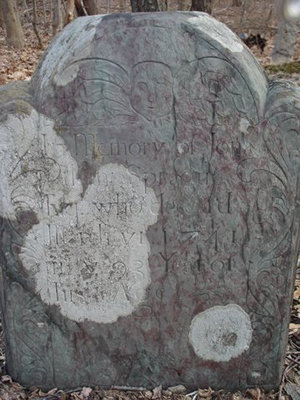 He served on many committees and commissions:
He served on many committees and commissions: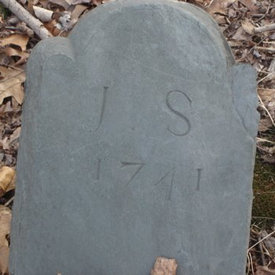 On May 23, 1719, Jonathan made an agreement with his sons-in-law William Jenckes, John Teft, and Daniel Brown, deeding them his house and all his lands. In return, they were to maintain him for life and he was to have choice of which son-in-law he would live with. They were also to maintain his horse and pay him 6 pounds a year and 25 pounds to such persons as he directed at his decease. This agreement must have been made while Jonathan’s wife’s health was failing. Mehitable died on October 19, 1719. On November 9th of that same year he deeded to his other son-in-law, Ebenezer Cook, certain lands. It is curious that Jonathan’s sons, Joseph and William, both of whom were living in Smithfield, are not mentioned either in these land transactions or for care of their father.
On May 23, 1719, Jonathan made an agreement with his sons-in-law William Jenckes, John Teft, and Daniel Brown, deeding them his house and all his lands. In return, they were to maintain him for life and he was to have choice of which son-in-law he would live with. They were also to maintain his horse and pay him 6 pounds a year and 25 pounds to such persons as he directed at his decease. This agreement must have been made while Jonathan’s wife’s health was failing. Mehitable died on October 19, 1719. On November 9th of that same year he deeded to his other son-in-law, Ebenezer Cook, certain lands. It is curious that Jonathan’s sons, Joseph and William, both of whom were living in Smithfield, are not mentioned either in these land transactions or for care of their father.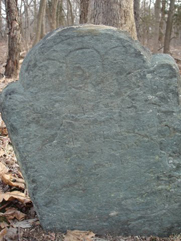 Mehitable Holbrook was born on June 29, 1649, in Weymouth, Norfolk, Massachusetts. She was the fifth of seven children born to William Holbrook, 29 and Elizabeth Pitts, 25 years old. On July 20, 1670, when she was 20 years old, she married Jonathan Sprague (above) in Weymouth, Norfolk County Massachusetts. They had six children – Joseph in 1672; Patience in 1674; Joanna in 1676; Persis in 1681; William on February 2, 1691; and Mary in 1697.
Mehitable Holbrook was born on June 29, 1649, in Weymouth, Norfolk, Massachusetts. She was the fifth of seven children born to William Holbrook, 29 and Elizabeth Pitts, 25 years old. On July 20, 1670, when she was 20 years old, she married Jonathan Sprague (above) in Weymouth, Norfolk County Massachusetts. They had six children – Joseph in 1672; Patience in 1674; Joanna in 1676; Persis in 1681; William on February 2, 1691; and Mary in 1697.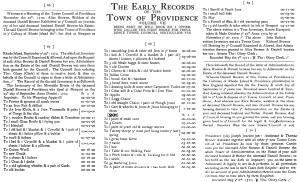
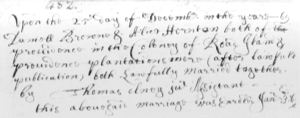
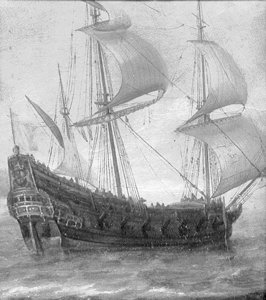 William Sprague is said to have been born on April 9, 1609, in Upwey, Dorset, England. He was the last of six children born to Edward and Christian Sprague. William’s father died in 1614 when William was not yet 5 years old. His mother remarried, so he was probably raised by his step-father John Corbin. When he was about 19, he traveled with his brothers Ralph and Richard in the Higginson Fleet which consist of six ships: The George Bonaventure, Lyon, Lyon's Whelp (pictured), Four Sisters, the Mayflower (on its fourteenth trip), and the Pilgrim (on its fourth trip). The fleet left Thames, Gravesend, England on April 5, 1629. Some say they were on the Lyon's Whelp, others say they were each on a different ship, but it is not known for sure. They followed Governor John Endicott who sailed earlier on the Abigail and landed at Salem, Massachusetts on September 6, 1628. The Sprague brothers arrived in Salem in 1929 where they were among the first settlers. They were employed by Governor Endicott to explore and take possession of the country westward. They traveled “through the woods to Charlestown, on a neck of land called Michawum, between Mystic and Charles rivers, full of Indians named Aborginians, with whom they made Peace.” Their chief, Monohaguaham, called John Sagamore by the English, was a man naturally of a “gentle and good disposition, by whose free consent they settled about the hill of the same place by the said natives called Mishawum, [afterwards called Charlestown,] where they found but one English pallisadoed and thatched house, wherein lived Thomas Walford, a smith, situate on the south end of the westermost hill of the East Field, a little way up from Charles River side, and upon survey, they found it was a neck of land generally full of stately timber, as was the main, and the land lying on the east side of the river, called Mystick River, from the farm Mr. Cradock's servants had planted called Mystick, which this river led up unto; and indeed generally all the country round about, was an uncouth wilderness full of timber.” There is no doubt whatever, but that the Spragues and their companions, were the first civilized men whose feet trod upon the soil, and whose eyes gazed upon the territory now Melrose, who explored with the view of making a permanent settlement.
William Sprague is said to have been born on April 9, 1609, in Upwey, Dorset, England. He was the last of six children born to Edward and Christian Sprague. William’s father died in 1614 when William was not yet 5 years old. His mother remarried, so he was probably raised by his step-father John Corbin. When he was about 19, he traveled with his brothers Ralph and Richard in the Higginson Fleet which consist of six ships: The George Bonaventure, Lyon, Lyon's Whelp (pictured), Four Sisters, the Mayflower (on its fourteenth trip), and the Pilgrim (on its fourth trip). The fleet left Thames, Gravesend, England on April 5, 1629. Some say they were on the Lyon's Whelp, others say they were each on a different ship, but it is not known for sure. They followed Governor John Endicott who sailed earlier on the Abigail and landed at Salem, Massachusetts on September 6, 1628. The Sprague brothers arrived in Salem in 1929 where they were among the first settlers. They were employed by Governor Endicott to explore and take possession of the country westward. They traveled “through the woods to Charlestown, on a neck of land called Michawum, between Mystic and Charles rivers, full of Indians named Aborginians, with whom they made Peace.” Their chief, Monohaguaham, called John Sagamore by the English, was a man naturally of a “gentle and good disposition, by whose free consent they settled about the hill of the same place by the said natives called Mishawum, [afterwards called Charlestown,] where they found but one English pallisadoed and thatched house, wherein lived Thomas Walford, a smith, situate on the south end of the westermost hill of the East Field, a little way up from Charles River side, and upon survey, they found it was a neck of land generally full of stately timber, as was the main, and the land lying on the east side of the river, called Mystick River, from the farm Mr. Cradock's servants had planted called Mystick, which this river led up unto; and indeed generally all the country round about, was an uncouth wilderness full of timber.” There is no doubt whatever, but that the Spragues and their companions, were the first civilized men whose feet trod upon the soil, and whose eyes gazed upon the territory now Melrose, who explored with the view of making a permanent settlement.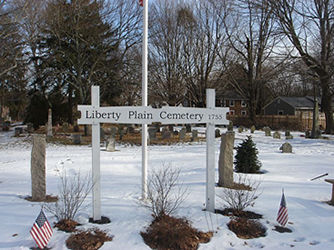 FIRST and principally, I commit and commend my soul into the hands of Almighty God, and my body to the earth, to be decently buried, at the discretion of my executor hereafter mentioned, hoping of salvation, both of soul and body, by the mercies of God in the merits of my Saviour Jesus Christ. And as for such temporal estate as it hath pleased God to bestow upon me, I do order, give and dispose the same in manner and form as followeth -- that is to say:
FIRST and principally, I commit and commend my soul into the hands of Almighty God, and my body to the earth, to be decently buried, at the discretion of my executor hereafter mentioned, hoping of salvation, both of soul and body, by the mercies of God in the merits of my Saviour Jesus Christ. And as for such temporal estate as it hath pleased God to bestow upon me, I do order, give and dispose the same in manner and form as followeth -- that is to say:
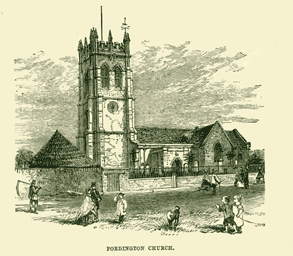 Millicent Eames was born about 1616 in Fordington, Dorset, England. She was the first of eight children born to Anthony Eames and Margery Pierce. She was baptized in St George Church (pictured right) with the name of her paternal grandmother, Millicent/Millisaint. In 1634, her family immigrated to the Massachusetts colony and settled in what became Hingham where Millicent met her future husband. Millicent had known the Sprague family all her life as her father's elder brother Richard Eames had married Alice Sprague from Upwey, and they had settled in Fordington in 1615. At about the age of 19, Millicent married William Sprague the youngest of the three Sprague brothers, in Charlestown, Suffolk Colony, Massachusetts, on May 26, 1635, (the year after her arrival). Millicent gave birth to at least 10 children – Anthony was baptized in Charlestown on May 23, 1636, and in 1661 married Elizabeth Bartlett; John was the first to be baptized in Hingham in April of 1638,and and in 1666, he married Elizabeth Holbrook, sister of ancestor Mehitable; Samuel was baptized on May 24, 1640; Jonathan was baptized on March 20, 1641/2, and died at 5 years old on July 4, 1647; Persis who was baptized on November 12, 1643, married John Doggett; Joanna, baptized in December, 1645, married Caleb Church in 1667; ancestor Jonathan; William was born on May 7, 1650, baptized two months later on July 2nd, and married Deborah Lane in 1674; Mary baptized on April 25, 1652, married Thomas King; and Hannah who was baptized on February 6, 1654/5, and died at 3 years old on March 31, 1658. Some researchers say there was another daughter, Elizabeth, baptized on May 2, 1641, but this researcher has not found any documentation to support this.
Millicent Eames was born about 1616 in Fordington, Dorset, England. She was the first of eight children born to Anthony Eames and Margery Pierce. She was baptized in St George Church (pictured right) with the name of her paternal grandmother, Millicent/Millisaint. In 1634, her family immigrated to the Massachusetts colony and settled in what became Hingham where Millicent met her future husband. Millicent had known the Sprague family all her life as her father's elder brother Richard Eames had married Alice Sprague from Upwey, and they had settled in Fordington in 1615. At about the age of 19, Millicent married William Sprague the youngest of the three Sprague brothers, in Charlestown, Suffolk Colony, Massachusetts, on May 26, 1635, (the year after her arrival). Millicent gave birth to at least 10 children – Anthony was baptized in Charlestown on May 23, 1636, and in 1661 married Elizabeth Bartlett; John was the first to be baptized in Hingham in April of 1638,and and in 1666, he married Elizabeth Holbrook, sister of ancestor Mehitable; Samuel was baptized on May 24, 1640; Jonathan was baptized on March 20, 1641/2, and died at 5 years old on July 4, 1647; Persis who was baptized on November 12, 1643, married John Doggett; Joanna, baptized in December, 1645, married Caleb Church in 1667; ancestor Jonathan; William was born on May 7, 1650, baptized two months later on July 2nd, and married Deborah Lane in 1674; Mary baptized on April 25, 1652, married Thomas King; and Hannah who was baptized on February 6, 1654/5, and died at 3 years old on March 31, 1658. Some researchers say there was another daughter, Elizabeth, baptized on May 2, 1641, but this researcher has not found any documentation to support this. 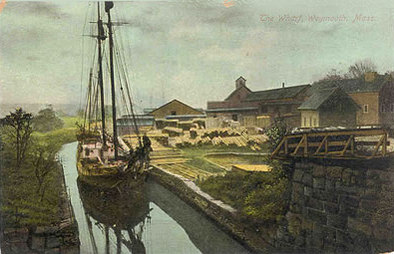 Records show that William was made Freeman in 1647 and resided at Weymouth. In 1660 he purchased land in Conihasset, but did not move there, he remained in Weymouth. In 1662 he was one of 10 citizens of Weymouth who were allotted 40 acres of land in Mendon, by the original grantee of that township, with the promise to settle there by the seventh month of 1663. In 1670 he bought 40 acres east of Mendon village from Moses Paine. He was known to have been Selectman and Deacon of the Congregational church, and Captain in the militia at Mendon. He was most likely living in Mendon at the beginning of King Philip's War, and must have experienced the burning of the town, and the perils of Indian warfare. It is said that in 1676 the Indian trouble forced him to leave Mendon and settle in Scituate, where he lived near the road from Cohasset to Scituate, ½ m W. of Capt Pierce's. He sold his original Mendon 40 acres on December 2, 1679, to his nephew Peter and sold other lands to his brothers, John and Thomas.
Records show that William was made Freeman in 1647 and resided at Weymouth. In 1660 he purchased land in Conihasset, but did not move there, he remained in Weymouth. In 1662 he was one of 10 citizens of Weymouth who were allotted 40 acres of land in Mendon, by the original grantee of that township, with the promise to settle there by the seventh month of 1663. In 1670 he bought 40 acres east of Mendon village from Moses Paine. He was known to have been Selectman and Deacon of the Congregational church, and Captain in the militia at Mendon. He was most likely living in Mendon at the beginning of King Philip's War, and must have experienced the burning of the town, and the perils of Indian warfare. It is said that in 1676 the Indian trouble forced him to leave Mendon and settle in Scituate, where he lived near the road from Cohasset to Scituate, ½ m W. of Capt Pierce's. He sold his original Mendon 40 acres on December 2, 1679, to his nephew Peter and sold other lands to his brothers, John and Thomas.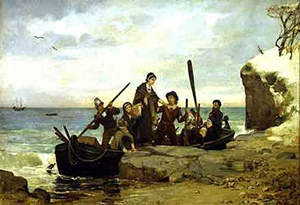 Elizabeth Pitts was born about 1624 in England to Mr. Pitts, possibly William (read more about this in her parents bios), and wife Elizabeth (maiden name unknown). She most likely came to America with her mother, and possibly her father and they probably settled in Dorchester, Massachusetts, just about 13 miles from Weymouth where her future husband lived. She was about 18 years old when she married William Holbrook in about 1642. It is believed they had seven children, all born in Weymouth – Samuel in 1643; Jane in 1645; Elizabeth in 1647; Hopestill in 1648; ancestor Mehitable; William on June 23, 1657; and Cornelius on November 19, 1662. Many researchers say there was another daughter named Persis, but she was their grand-daughter, child of their son Samuel.
Elizabeth Pitts was born about 1624 in England to Mr. Pitts, possibly William (read more about this in her parents bios), and wife Elizabeth (maiden name unknown). She most likely came to America with her mother, and possibly her father and they probably settled in Dorchester, Massachusetts, just about 13 miles from Weymouth where her future husband lived. She was about 18 years old when she married William Holbrook in about 1642. It is believed they had seven children, all born in Weymouth – Samuel in 1643; Jane in 1645; Elizabeth in 1647; Hopestill in 1648; ancestor Mehitable; William on June 23, 1657; and Cornelius on November 19, 1662. Many researchers say there was another daughter named Persis, but she was their grand-daughter, child of their son Samuel. 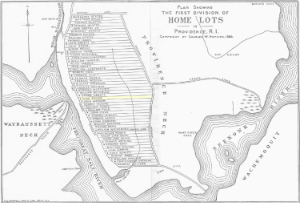
 Then there is the memorial stone, which was erected in 1792 in the North Burying Ground, that states, He died about A.D. 1665, which can’t be correct according to the above mentioned deed. This researcher believes he died prior to the tax list, because if he was alive on this date, his name should have been on that list and it isn't. Another reason why this researcher suspects he was dead prior to 1663 is an April 28, 1654 deed in which his land is listed as a boundary as “and 60 Acres belonging to Chade Browne formerly on the North.” If there was another owner of the land, it would most likely say, now owned by . . . or something to that effect. Being that no other owner is listed might mean he recently died and they weren’t quite sure who owned the land now. Two previous 1644 deeds where his land is listed as a boundary, simply say “the land of Chad Browne.” This by far is not conclusive evidence of the year of his death, but it seems it’s a good possibility.
Then there is the memorial stone, which was erected in 1792 in the North Burying Ground, that states, He died about A.D. 1665, which can’t be correct according to the above mentioned deed. This researcher believes he died prior to the tax list, because if he was alive on this date, his name should have been on that list and it isn't. Another reason why this researcher suspects he was dead prior to 1663 is an April 28, 1654 deed in which his land is listed as a boundary as “and 60 Acres belonging to Chade Browne formerly on the North.” If there was another owner of the land, it would most likely say, now owned by . . . or something to that effect. Being that no other owner is listed might mean he recently died and they weren’t quite sure who owned the land now. Two previous 1644 deeds where his land is listed as a boundary, simply say “the land of Chad Browne.” This by far is not conclusive evidence of the year of his death, but it seems it’s a good possibility.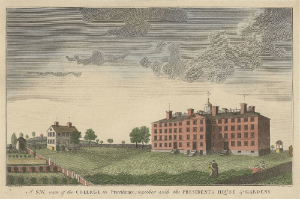

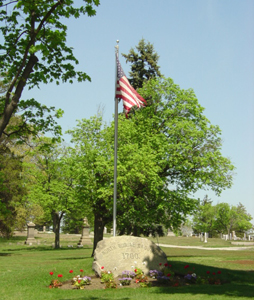
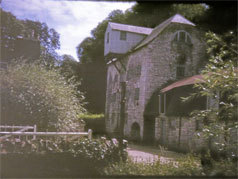 dward Sprague was born in 1576 in Dorset, England. His parents are not known, despite much research by many people. Tristam Sprague, long supposed to be the father has been shown to have no basis in fact. Simon Sprake is another possibility, but is also not supported by facts. In 1997 it was suggested that John Spragg(ue) might have been his father. At this point no one knows for sure, as many of the Dorchester records of that era no longer exist. Edward lived in Fordington, Dorsetshire, in early life. He was born in the 18th year of the reign of Elizabeth I, which followed the unsettled years following the death of her father, Henry VIII. At this time the county of Dorset with its rolling green landscape of meadows and tillage was lush. Agriculture especially sheep and cattle thrived. The Sprague family were by trade fullers, so that the plentiful supply of fleece and local weaving enabled their business to flourish. Fulling is a craft going back to ancient times that is an essential part of finishing newly woven cloth by cleansing and thickening it. The family tradition then was that the Spragues came from Flanders at about 1333, first into Devon and then migrated eastward to Dorset and that they taught the English in the west country the art of cloth making.
dward Sprague was born in 1576 in Dorset, England. His parents are not known, despite much research by many people. Tristam Sprague, long supposed to be the father has been shown to have no basis in fact. Simon Sprake is another possibility, but is also not supported by facts. In 1997 it was suggested that John Spragg(ue) might have been his father. At this point no one knows for sure, as many of the Dorchester records of that era no longer exist. Edward lived in Fordington, Dorsetshire, in early life. He was born in the 18th year of the reign of Elizabeth I, which followed the unsettled years following the death of her father, Henry VIII. At this time the county of Dorset with its rolling green landscape of meadows and tillage was lush. Agriculture especially sheep and cattle thrived. The Sprague family were by trade fullers, so that the plentiful supply of fleece and local weaving enabled their business to flourish. Fulling is a craft going back to ancient times that is an essential part of finishing newly woven cloth by cleansing and thickening it. The family tradition then was that the Spragues came from Flanders at about 1333, first into Devon and then migrated eastward to Dorset and that they taught the English in the west country the art of cloth making.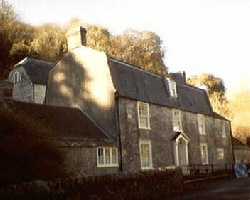 According to records there was a Mill situated on the banks of a stream drawn from the River Frome that ran through Dorchester in the vicinity of Fordington. It is said that this mill was used by the Sprague family for the purposes of fulling and that they lived nearby in a house on Mill Street. In1595 Edward married Christian, surname unknown, and they moved from Dorchester to live in
According to records there was a Mill situated on the banks of a stream drawn from the River Frome that ran through Dorchester in the vicinity of Fordington. It is said that this mill was used by the Sprague family for the purposes of fulling and that they lived nearby in a house on Mill Street. In1595 Edward married Christian, surname unknown, and they moved from Dorchester to live in 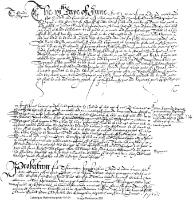
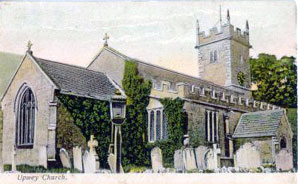 Edward possessed considerable property for his time, as his will and inventory show what was then considered a very large estate. The Latin version of the will also included a complete inventory of chattels, which included four beds furnished; a carpet; ten pair of sheets, board cloths, with two pair of pillow byes, and six table napkins; thirteen silver spoons; four coffers, one chest. two chairs and a flasket; a sword and dagger; a mill with many miller tools; a sack of wheat and a sack of malt; one table, board and cupboard; one and twenty brass vessels; butter and cheese; three saddles; four score sheep and forty-two lambs; one horse; seven kyne (cows), with three yearlings; one pyge (pig) and four acres and a half of corn, among many other items.
Edward possessed considerable property for his time, as his will and inventory show what was then considered a very large estate. The Latin version of the will also included a complete inventory of chattels, which included four beds furnished; a carpet; ten pair of sheets, board cloths, with two pair of pillow byes, and six table napkins; thirteen silver spoons; four coffers, one chest. two chairs and a flasket; a sword and dagger; a mill with many miller tools; a sack of wheat and a sack of malt; one table, board and cupboard; one and twenty brass vessels; butter and cheese; three saddles; four score sheep and forty-two lambs; one horse; seven kyne (cows), with three yearlings; one pyge (pig) and four acres and a half of corn, among many other items. 

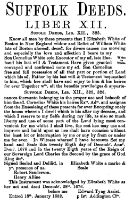
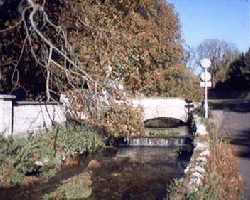 Nestling quietly in the valley of the Dorset Ridgeway is Upwey, sometimes spelt Upway. It lies approximately three miles North of Weymouth and takes its name from the River Wey. It is as it says the "up" part of the river and also where its source lies. The river begins as an underground spring rising up in the hill behind the Upwey Wishing Well. The river at Upwey is very picturesque, in places a shallow brook gently meandering through the valley. Further down it becomes a ford before turning back into a meandering stream down through Broadwey and Nottington to the village of Radipole and then out to sea.
Nestling quietly in the valley of the Dorset Ridgeway is Upwey, sometimes spelt Upway. It lies approximately three miles North of Weymouth and takes its name from the River Wey. It is as it says the "up" part of the river and also where its source lies. The river begins as an underground spring rising up in the hill behind the Upwey Wishing Well. The river at Upwey is very picturesque, in places a shallow brook gently meandering through the valley. Further down it becomes a ford before turning back into a meandering stream down through Broadwey and Nottington to the village of Radipole and then out to sea.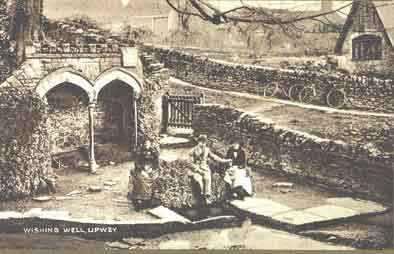 The famous wishing well will be found at the far end of the village, by the church. It was very popular in Victorian times when visitors could disembark from the train at the Upwey Wishing Well Halt. During this time it was known as the Upwey Wising Well.
The famous wishing well will be found at the far end of the village, by the church. It was very popular in Victorian times when visitors could disembark from the train at the Upwey Wishing Well Halt. During this time it was known as the Upwey Wising Well.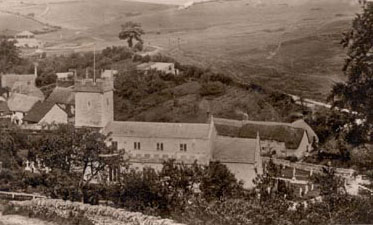 The church of St. Laurence dates from around 1490. The thirteenth century church is at one end of the village, somewhat out of the way. It stands next to the old village school, built in 1840 which is now used as the Village Hall.
The church of St. Laurence dates from around 1490. The thirteenth century church is at one end of the village, somewhat out of the way. It stands next to the old village school, built in 1840 which is now used as the Village Hall.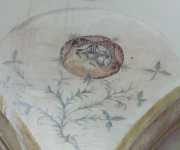 Its adornments include wall-paintings - the Tudor Roses painted on the arches of the arcade date from the late fifteenth century; a twelfth century font which was used as a pedestal for the capital in construction of the fifteenth century North Arcade; an ancient and Victorian stained glass, a Jacobean pulpit, both Tudor and Stuart links and some Green Men.
Its adornments include wall-paintings - the Tudor Roses painted on the arches of the arcade date from the late fifteenth century; a twelfth century font which was used as a pedestal for the capital in construction of the fifteenth century North Arcade; an ancient and Victorian stained glass, a Jacobean pulpit, both Tudor and Stuart links and some Green Men.